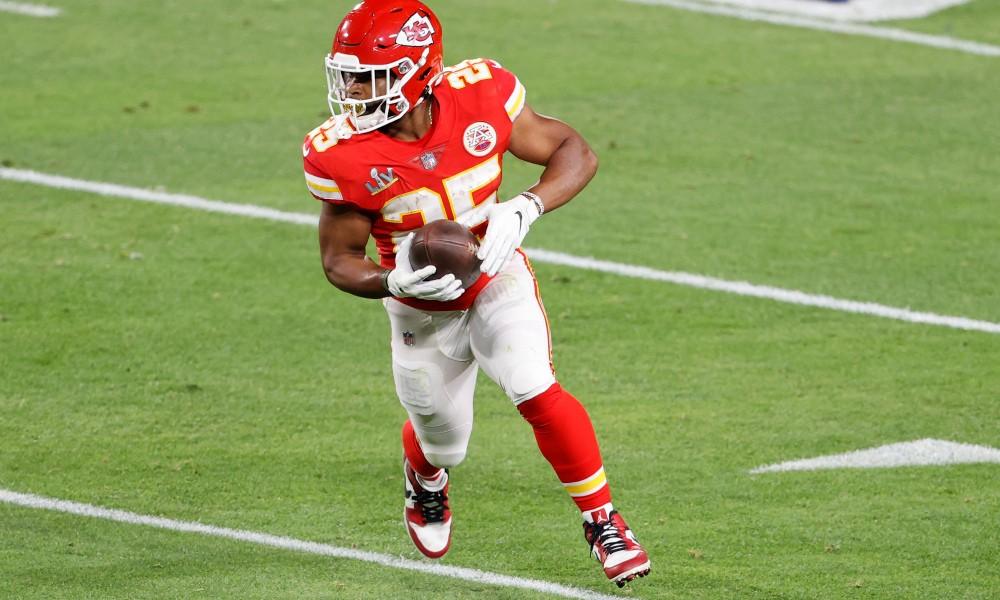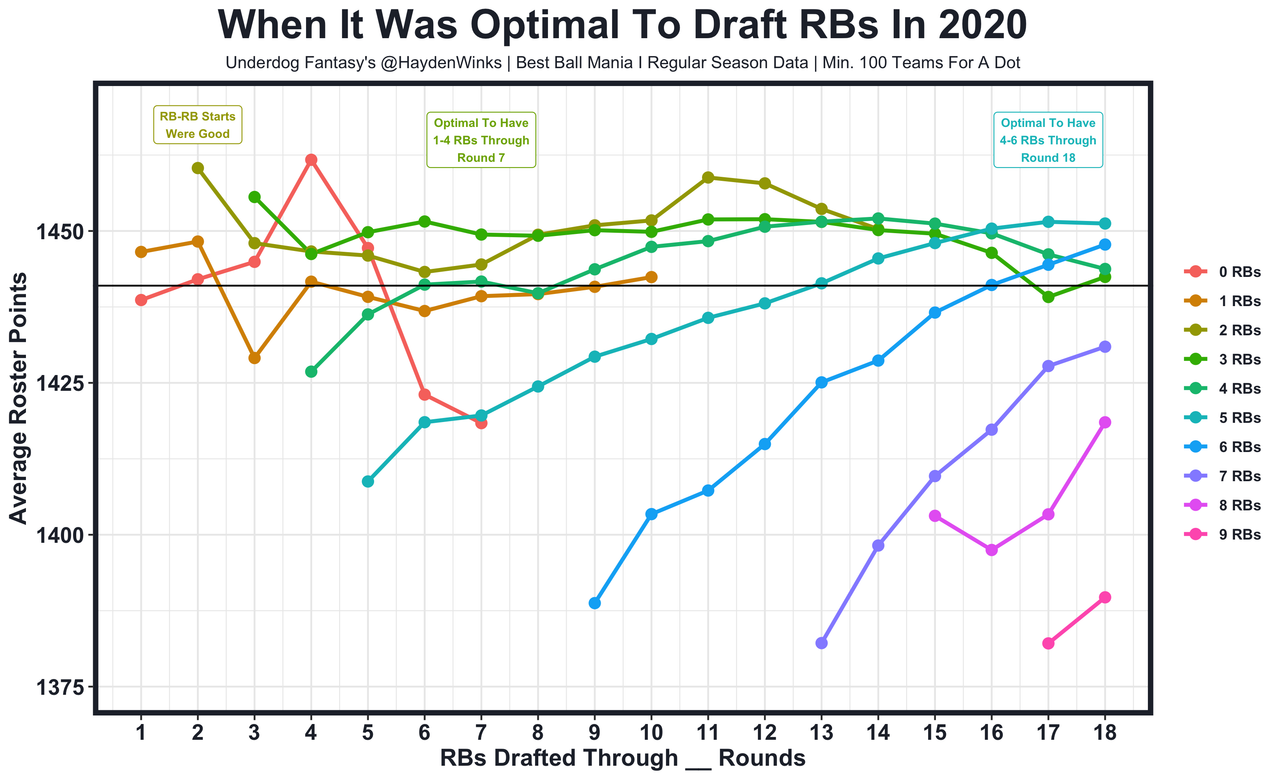When To Draft RBs on Underdog Fantasy

Last year at Rotoworld I wrote a column called “Bimodal RB”. In summary, I found that drafting 2 RBs within the first 3 rounds (typically the first 2 rounds though) was +EV. The data backed it up because it’s accomplishing a few things:
We’re avoiding the poor-performing low-end RB2s of the “RB Dead Zone” (Rounds 3–7).
We’re leaving ourselves the upside of hitting on a classic “Zero RB Target” in the early double-digit rounds when we finally draft our 3rd, 4th, and sometimes 5th RB.
But those “Zero RB Targets” don’t hit that often, so we’re not relying on them.
If we put all of this together, then we have my “Golden Rule of Best Ball”, which is to have 4 WRs by Round 7. But a lot of this research was based on PPR scoring, something I don’t care about now that I’m with Underdog Fantasy. RBs are unquestionably more valuable in half PPR than they are in full PPR, so I’m going to be putting more and more weight into half PPR best ball data as it continues to get released, something that just happened in June thanks to the Underdog Fantasy devs. So it’s time to update my thoughts on the RB position …
When to Draft RBs on Underdog Fantasy

Certainly beware of the one-year sample here, but this chart is very valuable in my opinion. It shows how many fantasy points each team scored in Best Ball Mania I based on how many RBs each team had by round. If you’re looking at the chart, the bottom is the round, meaning that “18” is when the draft was over. On the left side is average points scored in the regular season where better scores are higher up on the chart. We can think of these average points as a close replacement for “best ball win rate”. Finally, each color dot and line represents how many RBs each team has drafted.
For example, that light blue dot that I highlighted on the chart tells us that teams with 5 RBs through 5 rounds averaged a rough 1,409 fantasy points last year. Anything below 1,410 is unacceptable. Anything around 1,450 is really sick … Now that we know how to read the chart, let’s go into the highlights of it, starting with how many RBs was optimal (and recommended by me) through each round of Best Ball Mania I.
The RB Blueprint On Underdog Fantasy
Let’s start in Round 1 … Teams that drafted a RB in Round 1 averaged 7.9 more fantasy points than teams that didn’t draft a RB in Round 1. 83% of teams drafted a RB in Round 1 last year, basically only leaving teams who drafted Michael Thomas (bad), Davante Adams (elite), Tyreek Hill (elite), and Travis Kelce (elite) as the only non-RB teams. The fact that 3-of-4 of these players went off and that their teams still slightly underperformed on average compared to the RB in Round 1 teams shows that drafting a RB in Round 1 is at best optimal and at worst totally fine. As for which type of RB we should be targeting, I agree with sharp analyst Pat Kerrane when he recommended only shooting for elite upside with early-round RBs.
Onto Round 2 … Teams that drafted 2 RBs through Round 2 averaged 1,460 fantasy points. That was very good, in fact optimal last year in a vacuum. Teams that drafted only 1 RB averaged 1,437 fantasy points. The true Zero RB teams (0 RBs through Round 2) averaged 1,442. Particularly in a small sample, this isn’t damning evidence one way or the other, but “Bimodal RB” is looking good so far.
Time for Rounds 3 through 5 … In this range, there basically isn’t an obvious amount of RBs to have as long as you haven’t drafted more than 3 RBs. What I’m saying is that it doesn’t really matter what you do in the first two rounds! Wow, imagine thinking multiple strategies can work!
Okay, Round 6 time … This is officially the cut-off point of leaning too far into “Zero RB”. Teams that didn’t have a RB through Round 5 averaged 1,447 fantasy points. That number tanked to 1,423 fantasy points for teams who still didn’t have a RB through Round 6 last year. If you still don’t have a RB and you’re heading into Round 7 on Underdog Fantasy (a half PPR site!), then you’re just fishing for likes on Twitter.
Let’s fast forward to Round 10 … In the middle rounds, teams that had either 2 or 3 RBs were performing the best, followed by teams with either 1 or 4 RBs. More specifically, it was optimal to have 2 RBs through Round 8, Round 9, Round 10, Round 11, and Round 12 last year. “Bimodal RB” baby!!!
Almost done. Rounds 13 through 16 time … Once we get here, the data shows that we’re best off having either 3, 4, or 5 RBs, with a slight lean towards teams with just 3 or 4. Only having 0–2 RBs is a disaster. Having 6+ RBs is awful, too. The middle ground is the sweet spot.
Through Round 18 … When the draft is over, there is almost no difference between teams who drafted 3 RBs (1,455 fantasy points on average), 4 RBs (1,446), 5 RBs (1,451), and 6 RBs (1,446). Teams with 7 RBs dropped down to 1,430 fantasy points on average, and it only got worse from there if you go look at the chart again.
Conclusion
Because data is hard to wrangle, we’re still in the infant stage of optimizing best ball. That leaves the smartest people with an edge for the foreseeable future. One thing I *know* is being looked at incorrectly right now is optimizing roster construction only through the end of the draft. “It’s optimal to have 3–6 RBs!” is not where the conversation ends. That’s why I created the chart used in this column. It tells us a story about how teams get to 3 RBs, 4 RBs, 5 RBs, or 6 RBs by the end of the draft. Teams that drafted 3 RBs in the first 3 rounds don’t need 6 RBs. Teams that drafted 0 RBs through Round 5 can’t only draft 4 RBs. This is common sense, but I see mistakes like this being made literally multiple times every time I look at a best ball draft board.
More importantly, the data suggests that Zero RB (0 early-round RBs), Hero RB (1), Bimodal RB (2), and Robust RB (3) have merit as long as each drafter knows how to approach the middle and late rounds for that specific build. The draft board and our draft spot change each time we fire up another best ball draft, so it’s best to understand (and use!!!) all 4 strategies while we adapt to our current draft room.
Purely looking at last year’s Best Ball Mania I data, I think the best strategy was Bimodal RB because teams with 2 RBs through the middle rounds were being optimal and teams with 3 or 4 RBs in the double digit rounds were being optimal, but all strategies work. There’s no doubt about that!